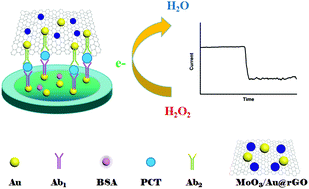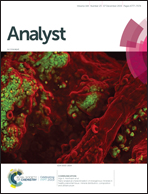Quantitative detection of procalcitonin using an electrochemical immunosensor based on MoO3/Au@rGO nanocomposites†
Abstract
In this work, a sandwich-type electrochemical immunosensor for the detection of procalcitonin (PCT) is constructed layer-by-layer with a novel label based on MoO3/Au@rGO nanocomposites. The high surface area and electroconductivity of graphene contributes to the transfer of electrons. Besides, the introduction of Au modulates the morphology of the MoO3@rGO nanocomposites from hexagonal prisms to agglomerated particles. Compared to rGO, Au@rGO and MoO3@rGO, the synergistic effect of MoO3/Au@rGO nanocomposites leads to the highest electrocatalytic activity towards H2O2 reduction. The electrochemical immunosensor exhibits a wide working range from 0.01 pg mL−1 to 10 ng mL−1 and a detection limit of 0.002 pg mL−1 at a signal-to-noise ratio of 3. Additionally, we also obtain excellent sensing performance for the immunosensor, including excellent selectivity, good reproducibility and stability. This work will give insight into the application of the nanocomposites based on noble metals combined with transition metal oxides in the fields of electroanalytical chemistry and biosensors.



 Please wait while we load your content...
Please wait while we load your content...